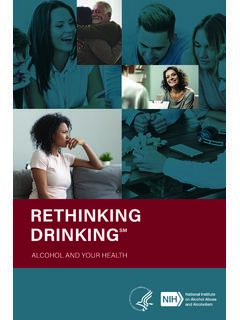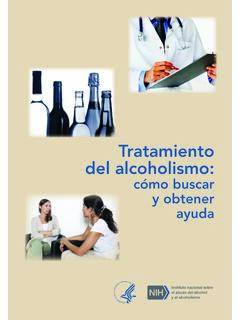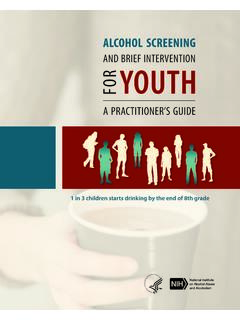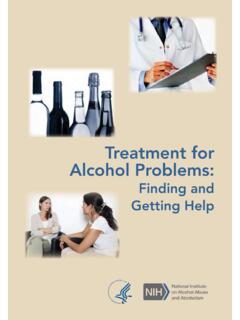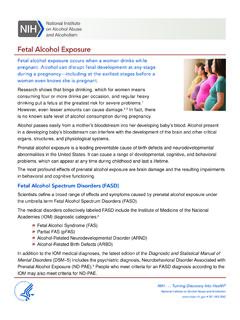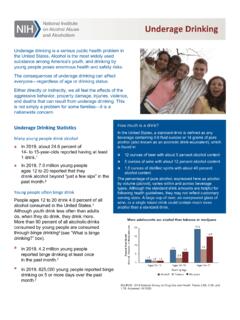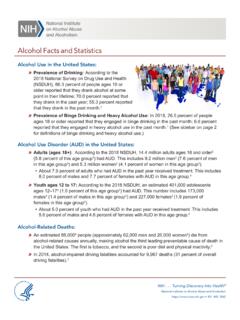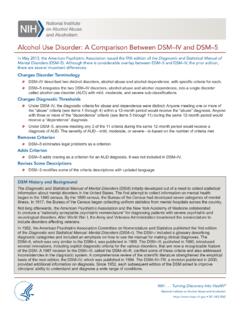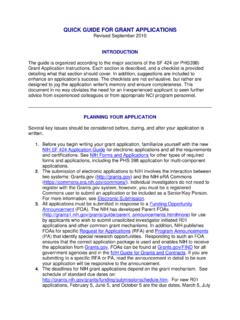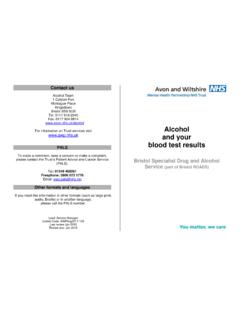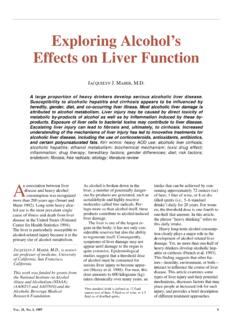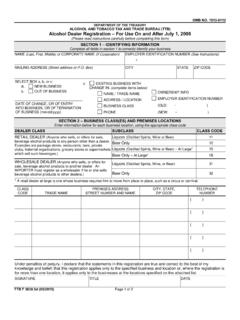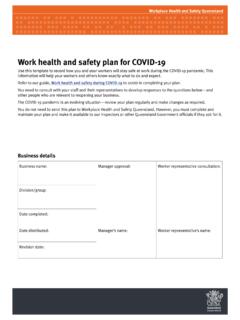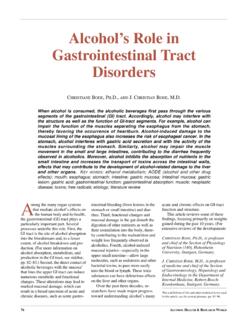Transcription of Understanding Alcohol Use Disorder Fact Sheet
1 * The National Institute on Alcohol Abuse and Alcoholism (NIAAA) defines binge drinking as a pattern of drinking Alcohol that brings blood Alcohol concentration (BAC) to percent or grams of Alcohol per deciliter or higher. For a typical adult, this pattern corresponds to consuming 5 or more drinks (male), or 4 or more drinks (female), in about 2 hours. ** NIAAA defines heavy Alcohol use as consuming more than 4 drinks on any day for men or more than 3 drinks for women. Alcohol use Disorder (AUD) is a medical condition characterized by an impaired ability to stop or control Alcohol use despite adverse social, occupational, or health consequences.
2 It encompasses the conditions that some people refer to as Alcohol abuse, Alcohol dependence, Alcohol addiction, and the colloquial term, alcoholism. Considered a brain Disorder , AUD can be mild, moderate, or severe. Lasting changes in the brain caused by Alcohol misuse perpetuate AUD and make individuals vulnerable to relapse. The good news is that no matter how severe the problem may seem, evidence-based treatment with behavioral therapies, mutual-support groups, and/or medications can help people with AUD achieve and maintain recovery. According to a national survey, million adults ages 18 and older1 ( percent of this age group2) had AUD in 2019.
3 Among youth, an estimated 414,000 adolescents ages 12 171 ( percent of this age group2) had AUD during this timeframe. What Increases the Risk for AUD? A person s risk for developing AUD depends, in part, on how much, how often, and how quickly they consume Alcohol . Alcohol misuse, which includes binge drinking* and heavy Alcohol use,** over time increases the risk of AUD. Other factors also increase the risk of AUD, such as: Drinking at an early age. A recent national survey found that among people ages 26 and older, those who began drinking before age 15 were more than 5 times as likely to report having AUD in the past year as those who waited until age 21 or later to begin drinking.
4 The risk for females in this group is higher than that of males. Genetics and family history of Alcohol problems. Genetics play a role, with hereditability approximately 60 percent; however, like other chronic health conditions, AUD risk is influenced by the interplay between a person s genes and their environment. Parents drinking patterns may also influence the likelihood that a child will one day develop AUD. Mental health conditions and a history of trauma. A wide range of psychiatric conditions including depression, post-traumatic stress Disorder , and attention deficit hyperactivity Disorder are comorbid with AUD and are associated with an increased risk of AUD.
5 People with a history of childhood trauma are also vulnerable to Alcohol Use Disorder What Are the Symptoms of AUD? Healthcare professionals use criteria from the Diagnostic and Statistical Manual of Mental Disorders, Fifth Edition (DSM-5), to assess whether a person has AUD and to determine the severity if the Disorder is present. Severity is based on the number of criteria a person meets based on their symptoms mild (2 3 criteria), moderate (4 5 criteria), or severe (6 or more criteria). A healthcare provider might ask the following questions to assess a person s symptoms. In the past year, have you: Had times when you ended up drinking more, or longer, than you intended?
6 More than once wanted to cut down or stop drinking, or tried to, but couldn t? Spent a lot of time drinking? Or being sick or getting over other aftereffects? Wanted a drink so badly you couldn t think of anything else? Found that drinking or being sick from drinking often interfered with taking care of your home or family? Or caused job troubles? Or school problems? Continued to drink even though it was causing trouble with your family or friends? Given up or cut back on activities that were important or interesting to you, or gave you pleasure, in order to drink?
7 More than once gotten into situations while or after drinking that increased your chances of getting hurt (such as driving, swimming, using machinery, walking in a dangerous area, or having unprotected sex)? Continued to drink even though it was making you feel depressed or anxious or adding to another health problem? Or after having had a memory blackout? Had to drink much more than you once did to get the effect you want? Or found that your usual number of drinks had much less effect than before? Found that when the effects of Alcohol were wearing off, you had withdrawal symptoms, such as trouble sleeping, shakiness, restlessness, nausea, sweating, a racing heart, or a seizure?
8 Or sensed things that were not there? Any of these symptoms may be cause for concern. The more symptoms, the more urgent the need for change. What Are the Types of Treatment for AUD? Several evidence-based treatment approaches are available for AUD. One size does not fit all and a treatment approach that may work for one person may not work for another. T reatment can be outpatient and/or inpatient and be provided by specialty programs, therapists, and doctors. Medications Three medications are currently approved by the Food and Drug Administration to help people stop or reduce their drinking and prevent relapse: naltrexone (oral and long-acting injectable), acamprosate, and disulfiram.
9 All these medications are non-addictive, and they may be used alone or combined with behavioral treatments or mutual-support groups. Behavioral Treatments Behavioral treatments, also known as Alcohol counseling or talk therapy, provided by licensed therapists are aimed at changing drinking behavior. Examples of behavioral treatments are brief interventions and reinforcement approaches, treatments that build motivation and teach skills for coping and preventing relapse, and mindfulness-based therapies. Mutual-Support Groups Mutual-support groups provide peer support for stopping or reducing drinking.
10 Group meetings are available in most communities, at low or no cost, at convenient times and locations including an increasing presence online. This means they can be especially helpful to individuals at risk for relapse to drinking. Combined with medications and behavioral treatment provided by health professionals, mutual-support groups can offer a valuable added layer of support. Please note: People with severe AUD may need medical help to avoid Alcohol withdrawal if they decide to stop drinking. Alcohol withdrawal is a potentially life-threatening process that can occur when someone who has been drinking heavily for a prolonged period of time suddenly stops drinking.
